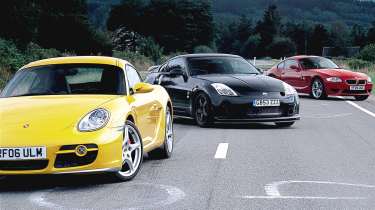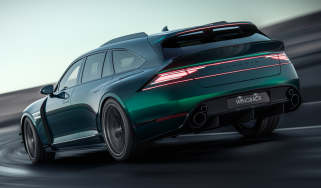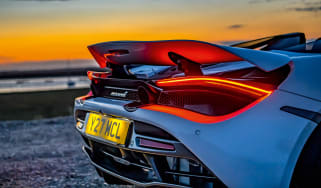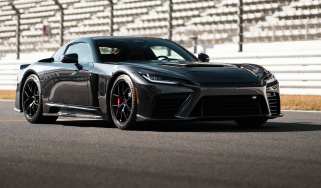BMW Z4 M Coupe v Porsche Cayman S v Nissan 350Z GT-S Concept: Battle of the Sixes
BMW's Z4 M Coupe and Porsche's Cayman S meet a potential six-cylinder rival: Nissan's 350z GT-S
Too often, coupes as a genre put style before substance. Think Alfa Brera. Think Chrysler Crossfire. With glittering aesthetics writing cheques the invariably underwhelming underpinnings can’t cash, it’s no wonder we rate so few of them as credible drivers’ cars.
Three exceptions to that rule are Porsche’s silky Cayman S, BMW’s sinewy Z4 M Coupe and Nissan’s gutsy 350Z. All are selfish two-seaters clothed in attention-grabbing sheet metal, and all are powered by high-quality six-cylinder engines: the Porsche by a 291bhp 3.4-litre flat-six, the BMW by a 338bhp 3.2-litre straight-six, and the Nissan by a 296bhp 3.5-litre V6.
Today, though, you can add another 82bhp to the Nissan’s power figure, because the 350Z we have here is the supercharged GT-S Concept. Built in their spare time by a group of engineers based at Nissan’s European Technical Centre in Bedfordshire, the GT-S Concept is currently a one-off, using aftermarket upgrades such as a Novidem supercharger, Strosek bodykit and Bilstein suspension to take the standard 350Z into more serious territory.
Encouragingly, Nissan says that the project has been done with an eye to offering upgrade kits, so there’s every likelihood that the GT-S Concept will progress beyond being just a concept. Best of all, the standard 350Z’s huge price advantage – it currently lists at £26,495, while the Porsche and BMW are both on the far side of £40K – means even a fully-fledged GT-S would undercut the other two at an estimated £36,500.
More reviews
Group tests
In-depth reviews
Long term tests
- Nissan 350Z Roadster: End of Term: Nissan 350Z Roadster
- Nissan 350Z Racer: Race against time
- Nissan 350Z Roadster
- Nissan 350Z Roadster
- Nissan 350Z Roadster
- Nissan 350Z Roadster
Reviews
With three prime examples of entry-level exotica at our disposal, we need a proper drive to do them justice. In a change from our usual blast through Brunstromgrad, we’ve decided to head into Europe, to Spa-Francorchamps, home of the finest Grand Prix circuit of them all, and an area blessed with some great public roads. It just so happens that trackday experts RMA are holding a two-day event on the GP circuit, too. And if that’s not the perfect incentive to make the schlep to Belgium, I don’t know what is.
After a SpeedFerries channel crossing that does a passable job of replicating the worst scenes from The Perfect Storm, we emerge from the bowels of the giant catamaran in Boulogne, tired but glad to be alive. The late-night autoroute grind is completed without incident (with Roger ‘Le Fugitive’ Green in our midst, that’s never a certainty), and it’s with some relief that we fall into our hotel at 1am.
After a short night’s sleep and a full Belgian breakfast of frites and mayonnaise, we make our way into the pine forests that surround the daunting four-mile Grand Prix circuit. Andy Morgan is keen to get some early shots in the bag, so we find a quiet stretch of road and line our trio up for a group static. Having spent most of yesterday in the Nissan, I’ve already decided that I’ll start the day with one of the German duo, but which to choose?
To my eyes, it’s the Z4 M Coupe that looks the more enticing option. Where the Z3-based Coupe was ugly-beautiful, its successor has matured into a genuinely handsome car. A riot of swoops and creases, exaggerated proportions and muscular curves, it’s a cohesive, eye-catching shape.
The boldness continues inside, with an abstract swage of brushed aluminium stretching the full width of the dashboard. Clear instruments and a low-slung, rear-set driving position make it feel focused and sporty, and, despite pedals that are slightly offset to the right, you’re soon comfortable and ready for action.
The urgent, metallic buzz of the M Coupe’s 3.2-litre straight-six is one of the classic modern engine notes, and one that fits the aggressively extrovert Z4 to a tee. There’s a familiar, mainstream feel to the clutch and gearshift, the former being light and progressive, the latter a little too springy and gristly to be rated anything more than average, but your surroundings and that engine do enough to make the Z4 feel special.
The rim of the steering wheel is as fat as your wrist, which is at odds with the keen immediacy of the chassis’ front-end response. You don’t need to cajole the M Coupe into a corner, so you don’t need a fistful of steering wheel to grab hold of. In fact, far from lobbing the nose at the apex, you need to rein things in, measuring your input against the lively steering response to match the front end’s modest grip. Even then you soon notice that the M Coupe is keen to push wide of your chosen trajectory, and that the best way to make clean, quick progress is to sacrifice some speed on the way in.
Sat a long way back from the pointy end, hips butting up against the rear wheels, Caterham-style, you’re somehow more aware of the Z4’s balance issues, and even when trying to drive with reserve and precision, you’re constantly aware of the need to play with the wheel and throttle, using the weight transfer to tuck the nose in. Struggling with understeer isn’t something you’d expect from a 340bhp, front-engined, rear-drive BMW, but that’s what you find yourself doing.
Between the corners, the Z4 really flies, fizzing through the gears with angry purpose and piling on speed in relentless, pulse-quickening style. It likes to scream, but there’s useable muscle to flex at low revs, too, so you can make swift progress without having to go banzai. The brakes – so often a source of scorn in M Power Bee Ems – are a little too keenly assisted. Not so much of a problem when you’re carrying a lot of pace, but they’re too abrupt at low speeds. And they grumble audibly when worked repeatedly. The stopping power remains encouraging, but sustained abuse does stretch them, raising questions about their outright ability.
The damping is as taut as you’d expect, with the Z4 jiggling in protest over broken surfaces. However, though busy, the M Coupe does manage to round-off the worst of the imperfections, and it takes a pothole of lunar proportions to send a crash through the structure. Tackle a bumpy road with the traction control system engaged, though, and it soon reminds you that the rear end could do with being in better contact with the ground. Even at a moderately quick pace (and on a dry road at that) the electronics can be felt intervening, so for smooth, uninterrupted progress, it’s best to switch the system off. And it’s probably best to leave the Sport button alone, as engaging it makes the throttle horribly snatchy and hard to modulate at small openings.
Despite these flaws, the M Coupe has an infectious character that goes a long way to compensate. It’s an exciting and extremely rapid car, with distinctive looks and a tremendous engine. The M badge always adds kudos, and there’s no denying the feel-good factor whenever you approach the car, open the door and slide behind the wheel. Perhaps the M Coupe’s biggest problem is that colleagues who have driven both the M Coupe and its little brother, the Z4 3.0si Coupe, say that the ‘lesser’ version is actually sweeter – and not much slower.
We don’t have a 3.0 Z4 here to prove the point, but swapping the M Coupe for the Cayman S is just as illustrative, for we know from experience that the Porsche is smoothness personified.
Awkward from some angles but awesome from others, the Cayman’s pebble-like profile and tight curves make an arresting sight, despite being painted in a hue that does it no favours.
Inside is sobriety itself, with plenty of black leather and plastic, together with those familiar crescent dials and fiddly centre-console controls. The driving position is close to perfect, although the steering wheel’s diameter does seem to be slightly too large. Fire the engine and the cockpit fills with a soft, whirring flat-six rasp emanating from just behind your shoulders, making you feel right at the centre of things.
As soon as you pull away you’re struck by the consistency of the controls. The steering is beautifully weighted and perfectly measured in its response, while the gearshift has an intuitive, oily quality that makes smooth driving a cinch. The chassis shares this easy, effortless feel, breathing with the road surface, filtering out the unwanted information and levelling the imperfections with total pliancy. Even when you engage Sport mode, the damping remains rounded, despite a tangible increase in tautness. The mid-engined layout means you don’t get the front-end patter and bobble that characterises a 911, and while some people will say this robs the Cayman of character, it also means that it copes with a broader range of surfaces and turns-in without a fight.
Winding through the fast, sinuous curves of our test route, the Cayman S is beautifully composed and totally keyed in to the road. The limits are high, but you can feel yourself squeezing progressively towards them, sensing the chassis settling in to each long corner, speed and lateral load building as you power towards the exit. Direction changes are made quickly and cleanly, with little inertia and no sense of any mid-engined twitchiness should you need to back off.
After the fierce power delivery of the BMW, it’s obvious that the Cayman’s modest 291bhp puts it at a disadvantage. You seem to spend more of your time with your right foot buried into the bulkhead, and while the engine is tremendously smooth and gloriously vocal under load, you don’t get the sense of raw accelerative drama that you get from the M Coupe.
Compensation comes in the form of great brakes, which are expertly judged, with plenty of feel and progressive initial bite. The pedal is well-weighted and enables you to minutely modulate the braking force, squeezing right to the point of ABS intervention if necessary. Coupled to the chassis’ impeccable manners, you’ve got a car that can be driven extremely hard without becoming ragged. Any speed lost out of a corner is clawed back on the way into the next.
Though its cross-country pace is similar to the M Coupe’s, it’s a very different animal.
A harmonious, polished package, it impresses on a cerebral level as much as an emotional one. Harder and sharper than the Boxster, yet more fluid and flattering than a 911, the Cayman is a subtle and addictively effective amalgam of everything Porsche does best.
It’s a tough act for the Nissan to follow, but don’t pity it, for parked alongside our two German protagonists there’s something mighty and menacing about the 350Z. The colour scheme helps, of course, but its more than a lick of black paint that gives the GT-S Concept such presence. Those smoky gold 18in Volk wheels fill the arches to perfection, while the bodykit seems to broaden the Nissan’s shoulders and hunker it down into the tarmac. Factor-in the huge intercooler lurking behind the hungry front intake and the trio of portholes bored deep into the nosecone, and you’ve got a thinly disguised street racer with all the visual swagger of the brutal Skyline GTR.
Then you start it up and things get a whole lot more serious. Exhaling through a vocal exhaust system, complete with bypass valves for added theatrical effect, the Z’s 3.5-litre V6 has a more raucous edge to its voice – and that’s before you finger the innocent switch mounted just ahead and right of the gearlever. Marked ‘Novidem’, it’s the blue touch paper that ignites the Swiss-made supercharger, which boosts the 350Z’s power output by some 82bhp (to 378bhp) and torque by a further 53lb ft (to 313lb ft): enough to make the Nissan the most potent car in this test.
The blower engages with a mild stammer before emitting a grin-inducing whistle in the manner of a toned-down version of Mad Max’s Interceptor. It’s a party piece of which you’d surely never tire, which is more than can be said for the piercing and almost constant hiss of what is presumably excess pressure bleeding from the blower once you’re on the move. It really is an extraordinary racket, not to mention painful if you’re subjected to a drive-by. It’s the only element that betrays the GT-S Concept’s aftermarket roots.
After the delicate tactility of the Cayman and the measured weight of the M Coupe, the Nissan’s major controls are extremely heavy. The clutch pedal, gearshift and steering all feel as though you’re trying to lift a dumbbell, which gives the Z a leaden, reluctant feel. It’s an impression that takes a good few miles to overcome, for the engine isn’t as crisp and free-spinning as the two Germans’ and the chassis tackles the tarmac in an altogether more combative style.
Rough surfaces result in jiggly progress, with the worst bumps sending an unsettling lateral shimmy through the car. But as the surface smoothes, the Z begins to hit its stride, flowing with authority and accelerating with big-lunged mid-range insistence. With grip to spare and a growing sense of poise and balance, you begin to get into the GT-S’s groove, and you soon find yourself revelling in a sequence of corners, right foot squeezing towards the floor as the chassis digs in and the supercharger gets on top of fourth gear.
It’s a muscular delivery, but one laced with the laidback demeanour of a big-capacity engine. It doesn’t suit being wrung out for every last rev, as the V6 isn’t the smoothest, but if you accept that it does its best work between 3000 and 6000rpm, there’s plenty of performance on offer and fun to be had, although it never feels quite as rapid as close to 400bhp would have you expect.
The heavyweight controls suit this style of delivery. The physical effort required to get the best from the Nissan makes you feel truly involved, and the fact that there are a few rough edges (the clutch is sharp at low speeds and the revs don’t decay quickly enough between gears) means finding an empathy with the car makes a big difference.
Perhaps because of the effort – both physical and mental – the Nissan is the most wearing to drive any distance. Engine noise is omnipresent and there’s a good deal of road noise too, drummed up by the broad ContiSportContact 2 rubber. Early 350Zs were never the last word in hushed isolation, and though refinement has improved in recent examples, the GT-S Concept is old-school noisy and therefore not for those of a sensitive disposition.
Three terrific cars, then, but as we’ve discovered, none of them is perfect. Not even the Cayman. So polished and accomplished, it’s exactly what you’d expect a Porsche to be. Predictable, exploitable, and precisely honed, it sounds and feels the sweetest. Trouble is, despite the diamond-cut dynamics, it doesn’t have the more visceral performance offered by the others.
Both the BMW and the Nissan have more dominant, vibrant characters. The M Coupe almost quivers with intensity and sharp-edged urgency, while the more methodical, brutal 350Z pulses with heavyweight physicality and streetwise menace. By comparison, the Cayman is milder and inoffensive, but it pays to keep your perspective, for despite the lack of rough edges, this near-300bhp Porsche is a long way from being sterile. What it has in spades is completeness and cohesion, with every major facet connected by a level of tactile homogeneity of which the others can only dream. It’s a class act, no doubt.
That’s why, despite the best efforts of two undeniably entertaining challengers, it’s the Cayman that gets the nod. With greater poise than the M Coupe and more delicacy than the 350Z, its chassis is a more satisfying partner, while its smooth, cultured flat-six spins and sings sweeter than either the bruising but brittle BMW straight-six or the heavy-breathing Nissan V6. Factor-in better brakes, the slickest gearshift and the least intrusive, most effective electronic stability system, and the slight lack of straight-line fireworks seems less of a problem.
Many of you will groan at this point, feeling that the Cayman is the obvious choice. You’re right, it is, but that’s because, like its big brother, the 911, the Cayman sets the class benchmark, achieving a rare balance of character and competence its rivals simply can’t match.
Comparison
| BMW Z4 M Coupe | Porsche Cayman S | Nissan 350Z GT-S | |
| Engine | In-line 6-cyl | Horizontally opposed 6-cyl | V6 |
| Location | Front, longitudinal | Mid, longitudinal | Front, longitudinal |
| Displacement | 3246cc | 3387cc | 3498cc |
| Bore x stroke | 87 x 91mm | 96 x 78mm | 95.5 x 81.4mm |
| Cylinder block | Cast iron | Aluminium alloy, dry-sumped | Aluminium alloy |
| Cylinder head | Aluminium alloy, dohc, 4v per cylinder, VANOS | Aluminium alloy, dohc per bank, 4v per cylinder, VarioCam Plus | Aluminium alloy, dohc per bank, 4v per cylinder, VVT |
| Fuel and ignition | Electronic engine management, multi-point fuel injection | Electronic engine management, multi-point fuel injection | Electronic management, multi-point injection, supercharger |
| Max power | 338bhp @ 7900rpm | 291bhp @ 6200rpm | 378bhp @ 6850rpm |
| Max torque | 296lb ft @ 4900rpm | 251lb ft @ 4400rpm | 313lb ft @ 5130rpm |
| Transmission | Six-speed manual, rear-wheel drive, M differential, DSC+ stability control | Six-speed manual, rear-wheel drive, limited-slip differential, PSM | Six-speed manual, rear- wheel drive, limited-slip differential, TCS, ESP |
| Front suspension | MacPherson struts, coil springs gas dampers, anti-roll bar | MacPherson struts, coil springs, PASM damping system, arb | Multi-link, coil springs, gas dampers, anti-roll bar |
| Rear suspension | Multi-link, coil springs, gas dampers, anti-roll bar | MacPherson struts, coil springs, PASM damping system, arb | Multi-link, coil springs, gas dampers, anti-roll bar |
| Brakes | Drilled and vented discs, 345mm front, 328mm rear, ABS, EBD | Drilled and vented discs, 318mm front, 299mm rear, ABS | Vented discs, 324mm front, 322mm rear, ABS, EBD, NBA |
| Weight (kerb) | 1424kg | 1350kg | 1525kg |
| Power-to-weight | 241bhp/ton | 219bhp/ton | 252bhp/ton |
| 0-62mph | 5.0sec (claimed) | 5.4sec (claimed) | 4.8sec (claimed) |
| Max speed | 155mph (limited) | 171mph (claimed) | 155mph (limited) |
| Basic price | £41,285 | £44,080 | £36,500 (est) |



